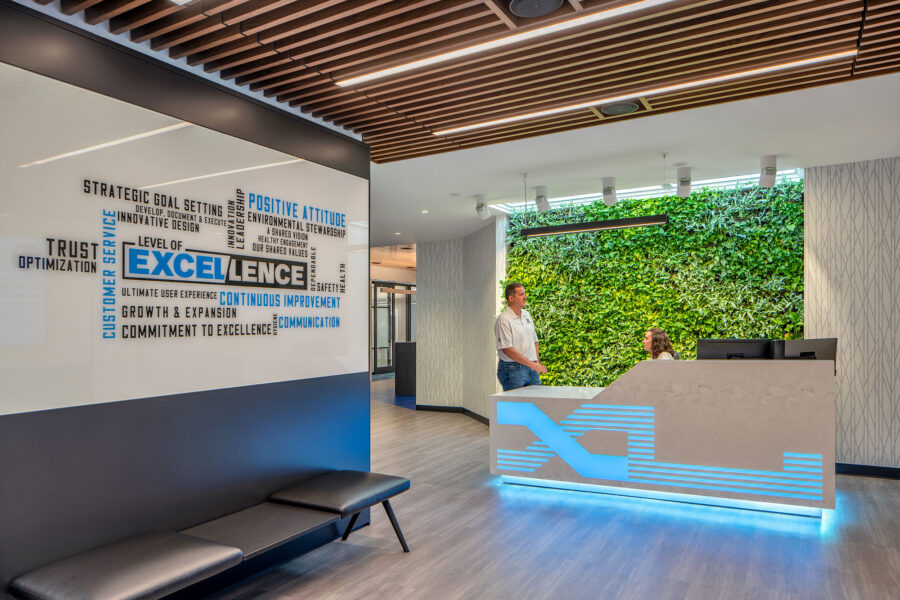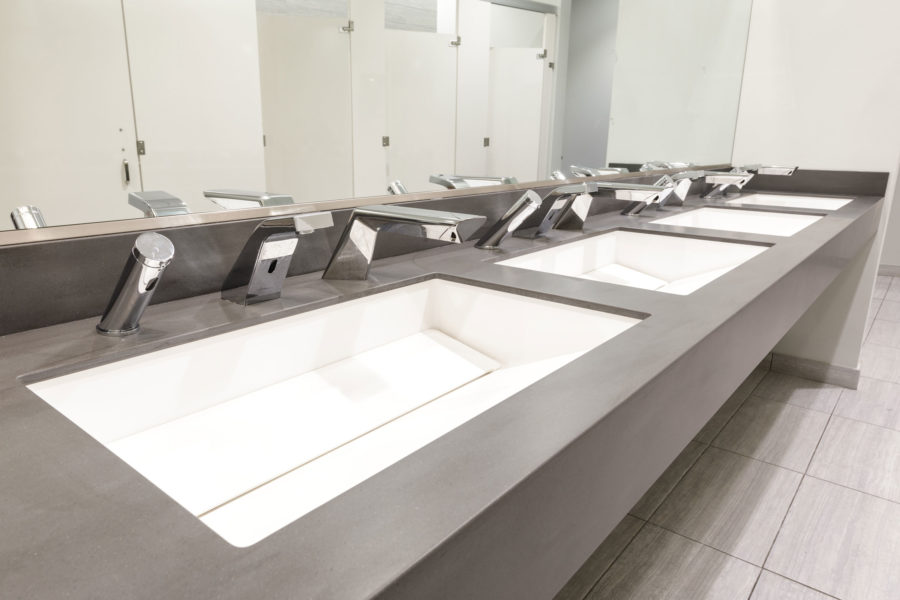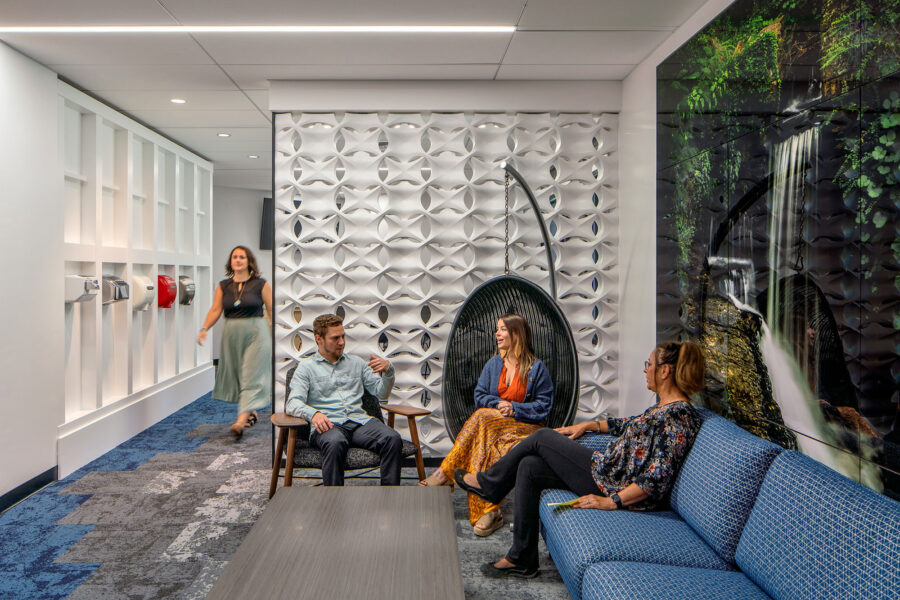Story at a glance:
- Excel Dryer walks its talk with a headquarters renovation and expansion that is in process of completing certification for the WELL Building Standard.
- Excel hand dryers are part of an overall healthy workplace.
- The journey to achieving WELL is shared in a continuing education credit course for architects, designers, contractors, managers, and owners.
“Clean hands save lives.”
Those are the words of Bill Gagnon, executive vice president and COO of Excel Dryer, which he says in reference to restroom handwashing. And while the virus responsible for Covid was largely airborne, hand hygiene was a factor as well.
Just as importantly, proper handwashing can stop a variety of other communicable diseases that make people seriously sick. The diseases that can be transferred from hand and surface contact include infections of the upper respiratory tract (adenovirus, rhinovirus), eyes (conjunctivitis), skin (impetigo, ringworm, folliculitis), and both the upper and lower digestive tracts (norovirus, influenza, rotavirus).
Gagnon was referring to bathrooms anywhere and everywhere because, well, bathrooms are a universal experience in the developed world. And he practices what he preaches in the company’s home offices in Massachusetts. A recent renovation and expansion of the company’s headquarters was designed to achieve the WELL Building Standard—a performance-based system for measuring, certifying, and monitoring features of the workplace that impact worker health and well-being.
“WELL is the next generation of a focus on health and wellness,” Gagnon says. The company already had a LEED Gold–certified office prior to the 2023 renovation and expansion, which increased the company’s administrative offices from 5,000 to 10,000 square feet. “We’ve always pushed to have the latest and greatest in sustainability. And now this is about our people living in a building.”
Happier, Healthier Workplaces

A recent renovation and expansion of Excel Dryer’s own headquarters was designed to meet the WELL Building Standard. Photo courtesy of Excel Dryer
WELL measures building performance across 10 concepts:
Air Quality (removal of contaminants, prevention, and purification)
Water (removal of contaminants through filtration and treatment, as well as strategic placement of water stations)
Nourishment (encourage healthy eating habits through healthier choices and behavioral cues)
Light (minimize disruption to human circadian rhythms through windows/natural lighting, lighting controls, and task-appropriate illumination levels)
Movement (encourage physical activity through workplace design)
Thermal Comfort (distraction minimization, productive and soothing indoor environments, thermal and acoustic controllability)
Sound (identifying and mitigating acoustical comfort)
Materials (reducing occupant exposure to harmful chemicals)
Mind (support mental and emotional health through design, relaxation spaces, and technology)
Community (engaged occupant with community)
“These measures reduce headaches,” says Gagnon, referring to the literal pain inside the cranium that can occur in workplaces subject to what’s known as sick building syndrome. “With happier and healthier people we see increased productivity.”
Within the WELL Building Standard handwashing is subdivided into four categories—supplies, contamination reduction, sink dimensions, and the number of hand-washing station locations. Excel’s business, electric hand dryers, earn certification points because the touchless, sensor-activated machines preclude touching surfaces as could be required in hand towel dispensers and have an electrostatic HEPA (eHEPA®) Filtration System. These remove 99.999% of viruses and 99.97% of potentially present bacteria (0.3 microns and larger) from the airstream, Gagnon says.
Additionally, the company’s flagship products—XLERATOR®, XLERATOReco®, ThinAir®, and the XLERATORsync®—promote healthy restrooms in other respects. That includes elimination of paper towel waste, which can clutter public restrooms with waste receptacle overflow. Also, paper towels often end up in toilets, leading to clogs, water flooding floors, and resultant bacteriological effects.
Restrooms are Evolving

Restrooms at the Optum Field Lounge at Gillette Stadium, home of the New England Patriots, were renovated to include Excel Dryer products. Photo courtesy of Excel Dryer
Bathroom soaps, faucets, and hand-drying methods have evolved considerably in recent years to achieve these criteria. Touchless faucets and soap dispensers have become fairly common. More recently the D|13 Group—the exclusive dealer of integrated sink systems, featuring the XLERATORsync hand dryer—has made it easier for designers to incorporate touchless hand hygiene into commercial restrooms. Their custom-designed sink systems complete the process—wash, rinse, and dry all in one place. The reverse airflow technology of the XLERATORsync dryer works in concert with the custom dimensions of the sink basin to ensure the high velocity air and water stay away from the user and in the basin where they belong, creating an elevated user experience.
Not only do the features of the hand dryers protect individual users, as measured against recycled paper towels, but Excel dryers are better at protecting the environment as well. Life cycle analyses conducted in 2009 and again in 2023 found that the electric-powered dryers performed exceptionally better in reduced energy consumption and pollutants generated, regardless of the energy source (renewables and fossil fuel-generated power). This factor enables the electric dryers to earn LEED points for building owners.
Electric-powered dryers performed exceptionally better in reduced energy consumption and pollutants generated.
Touchless and tidy restrooms have commercial value that designer-specifiers know well. Basic cleanliness is what their clients need and want. Clean bathrooms, or a lack thereof, are known to reflect on a commercial establishment that provides them. One recent survey shows there is a universal—as in 100% of respondents—belief that a dirty bathroom reflects poorly on the organization overall. That survey also showed the single most-noticed indicator of a poorly maintained restroom is when paper towels overflow a trash receptacle.
Architects and interior designers are gradually becoming acquainted with the features that meet the WELL Standard. When Gagnon’s team sought out an architecture firm with WELL experience the field was narrow. The firm they chose, Fennick McCredie Architecture, had just one prior project that achieved WELL. The certification is new enough, established in 2013, that it’s not quite as well-known as LEED (born in 1998). “We were excited to learn about this together,” Gagnon says.
The senior lead architect, Katherine Brekka, agrees. “Being a part of this groundbreaking project was an extraordinary experience,” she says. “The innovative blend of space, beauty, and wellness achieved is something I’m incredibly proud of. It represents a forward-thinking approach to workplace design that I was thrilled to contribute to and see come to life.”
Going WELL

A social nook inside the new Excel Dryer headquarters invites employees to take a break. Photo courtesy of Excel Dryer
Learning is an intrinsic part of the journey to early adopters of WELL. Gagnon shares that employees of Excel, in particular those who worked on the documenting process to support the goal to achieve certification, “had their eyes opened.”
Some of those same employees are featured in an educational video that accompanies a continuing education unit (CEU) course Excel co-authored for architects, designers, contractors, building managers, and owners. The course, The WELL Building Standard – Commercial Office Space, tracks Excel’s journey through the headquarters design and renovation, emphasizing the role of touchless hand hygiene. The course is offered by Architectural Record magazine’s Continuing Education Center; CEU credits are honored by the AIA, USGBC, American Institute of Building Design, and a dozen more professional associations.
“For our business the vision was to answer, ‘What can we do here to be beautiful, sustainable, and healthy?’” Gagnon says. “We also wanted it to be educational—and especially to show in the post-Covid world how it could be done. I notice the responses we get to our new offices reminds me of when we introduced the XLERATOR. Everyone comments positively on it. It was worth the time and investment.”

